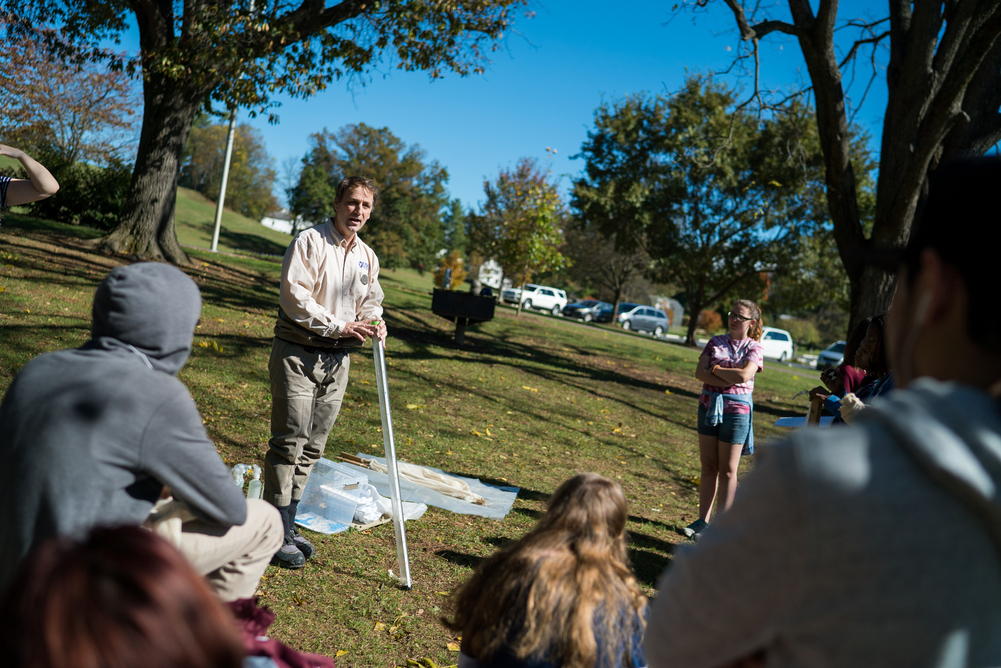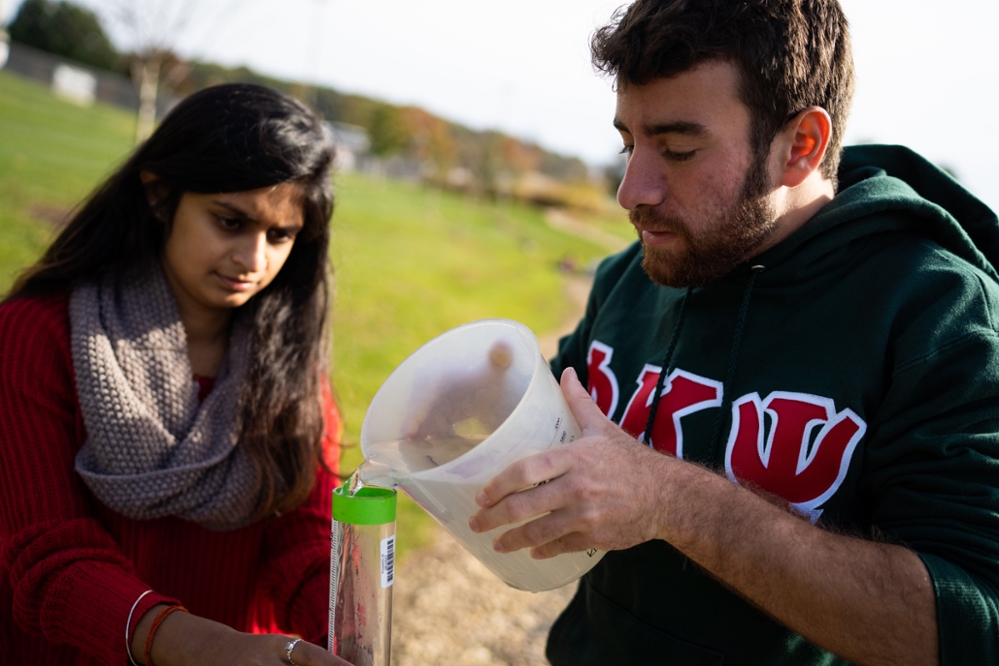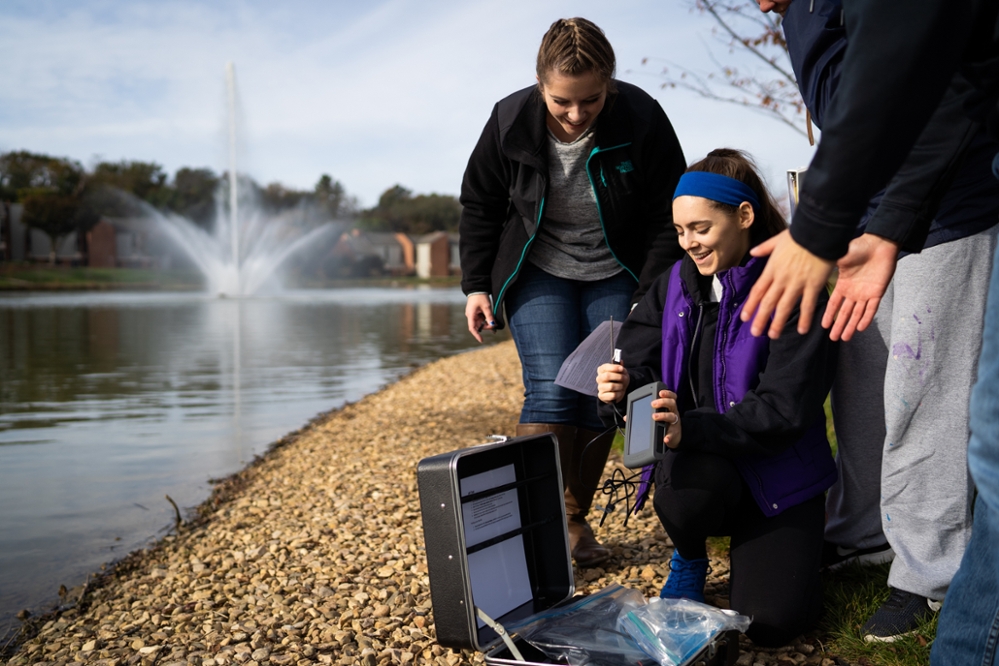Water quality research brings educational opportunities to a community
Research
By Peace Ningabire (‘20) and Ben Delp (‘05), JMU Research & Scholarship
James Madison University adopted a new vision in 2014 – To be the national model for the engaged university: engaged with ideas and the world. While the vision is nearing its fifth birthday, JMU faculty have exemplified this vision for decades. One such example is School of Integrated Sciences faculty Dr. Thomas Benzing, who teaches courses in both the Integrated Science & Technology (ISAT) and Geographic Sciences programs. Dr. Benzing’s research focuses on water quality and habitat restoration, most notably in the City of Waynesboro’s South River, which became contaminated with mercury as a result of industrial pollution from the 1930s through 1950s. With a background in Chemistry and Crop and Soil Sciences/Environmental Toxicology, Professor Benzing has served as a research scientist with the South River Science Team and the Shenandoah River Fish Kill Task Force, and is currently a Research Associate and Trustee with the Virginia Museum of Natural History (VMNH), a state agency located in Martinsville.
As Vice-Chair of the VMNH Board of Trustees, Benzing serves as an advisor to the director of the museum and helps to develop strategic goals for the agency. He has also served on both the VMNH research and educational committees, focusing on distance learning programs where elementary students get to explore science and learn about the fascinating research and collections of the museum. His efforts have recently led to a collaborative opportunity between JMU and the museum. Through the upcoming College for Kids program (scheduled for January and February 2019), JMU and VMNH will partner to deliver “Uncovering Mysteries with Fossils and Bones,” a course to engage approximately two dozen fourth through sixth graders in science and encourage discovery of new talents and interests.
 |
| JMU students from ISAT 112 (Environmental Issues in Science and Technology) analyze samples from Newman Lake to test for water quality (for example, water temperature, water clarity, and dissolved oxygen). |
Further engaging our local community, Benzing is currently part of a regional initiative to create a branch campus of the Virginia Museum of Natural History in downtown Waynesboro. A facility to interpret the region’s natural history would have a significant impact on the Waynesboro economy and provide interactive and dynamic educational programs for the Central Shenandoah region and out of town visitors. Educational offerings are expected to include both on-site and distance learning programs focusing on different areas of scientific study, such as paleontology and archaeology, as well as interactive exhibits like aquatic “touch tanks” for visitors of all ages. VMNH is currently working with an architectural and exhibit design firm to develop the building design. “It’s exciting when you imagine how this facility will serve the community of Waynesboro both educationally and economically,” said Benzing.
 |
| JMU students from ISAT 112 (Environmental Issues in Science and Technology) analyze samples from Newman Lake to test for water quality (for example, water temperature, water clarity, and dissolved oxygen). |
Benzing first became involved with the Waynesboro community through JMU’s Professor-in-Residence (PIR) program, which promotes postsecondary study and college aspirations of Virginia high school students, especially students who have historically lacked sufficient opportunities for attending colleges and universities. At Waynesboro High School, his PIR activities include field trips to the South River at Ridgeview Park to sample macroinvertebrates (stream insects) and conduct water quality tests. Additionally, Benzing has arranged for Waynesboro students to visit labs at JMU that complement their high school classes, including a cadaver lab for students enrolled in anatomy, and physical therapy labs for those studying sports medicine.
 |
| JMU students from ISAT 112 (Environmental Issues in Science and Technology) analyze samples from Newman Lake to test for water quality (for example, water temperature, water clarity, and dissolved oxygen). |
From a research perspective, mercury remediation and improving the water quality of the South River is a team effort at JMU, as the scholarly interests of Dr. Benzing are shared by ISAT Associate Professor Robert Brent and Biology Professor Christine May, along with a number of JMU students representing both the College of Integrated Science & Engineering and the College of Science & Mathematics. Dr. Benzing and his colleagues have had the opportunity to present their research to a variety of academic and community organizations, including an invited talk during the 2015 Meeting of the Virginia, Virginia Tech, and West Virginia Chapters of the American Fisheries Society titled A natural history interpretive center and coldwaters research opportunities of the South River in Waynesboro, Virginia.
JMU faculty anticipate that the Waynesboro museum facility will encourage additional research collaborations while promoting healthy, natural systems in a region that has had its fair share of environmental challenges. While a project of this size will take time, a significant, near-term impact is “…the synergy that exists between our efforts to bring this campus to Waynesboro and the ongoing mercury remediation efforts to restore South River’s ecology,” said Dr. Benzing.
